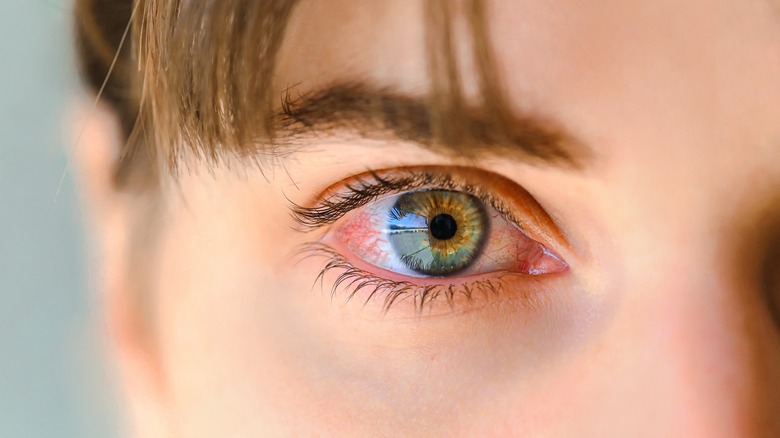Your Sun Protection Routine Might Be Missing An Essential Part Of Your Face
While we all enjoy a moment in the sun, health experts have offered a laundry list of warnings about getting too much sun. No matter the season, you need to incorporate ways to get sunscreen into your routine. You should be equally cognizant of potential sun damage during the colder months, too. Harmful UVB rays are dangerous all 12 months of the year (via SkinCancer.org). That may raise some questions. How much sun protection do you need? What does the best sun self-care look like? Do you need to protect more than just your skin from the sun's rays?
But it isn't just your skin that requires protection from the sun. Yes, you need to protect both your skin and hair from sun damage, but there's more: your eyes could also be at risk of danger. The easiest way to ensure that you adequately safeguard your eyes is to incorporate sun protection into your daily routine. Preserve your eyes' safety by checking this vital step off your list when getting ready for your day.
Don't forget about your eyes when preventing sun damage
Like your skin and hair, your eyes are sensitive to sun damage. According to the Cleveland Clinic, your eyes are at risk of sun-induced irritation when you spend significant time outside. Too much sun in your eyes can cause symptoms ranging from slight discomfort to intense pain. Ultraviolet exposure is a risk that comes with many recreational activities, per UpToDate. Hiking, bike riding, and winter sports like skiing and snowboarding require adequate eye protection.
Too much sun exposure can lead to a condition called photokeratitis, which is like sun-burned eyes, according to the American Academy of Ophthalmology. You are more likely to get a bad case of this painful eye condition from looking down than looking up. Reflections from snow, sand, or water can bounce UV rays into your eyes. Staring directly into the sun during a solar eclipse is another prominent cause of this acute syndrome.
Symptoms of photokeratitis include eye pains, red eyes, damaged vision, and headaches (via the Cleveland Clinic). However, these symptoms can take time to set in, sometimes taking anywhere between six and 12 hours after being outside.
How to prevent photokeratitis with this vital step in your routine
Photokeratitis can be prevented by using adequate eyewear protection, experts say. According to the American Academy of Ophthalmology, the easiest way to guard your eyes against the painful symptoms of photokeratitis is to wear sunglasses that block UV rays. Plenty of stylish and well-known brands offer sunglasses that absorb light and block harmful UV rays. Per the Miami Herald, the best sunglass brands for looking good and protecting your eyes are Ray-Ban, Maui Jim, and Warby Parker.
If you get too much sun exposure in your eyes, you may need medical attention, via the Cleveland Clinic. When first experiencing the symptoms of photokeratitis, go inside and stay in a dark space. If you wear contact lenses, take them out and avoid touching your eyes. You can take over-the-counter drugs to hold the pain at bay. For more relief, apply a cold washcloth to your eyes. Usually, symptoms go away after a day, per the American Academy of Ophthalmology. If the pain continues for more than two days or you lose your vision, seek medical attention.
Wearing sunglasses is a deceivingly simple way of your routine that will pay off in the long run. Protect your eyes and look stylish in the process.


